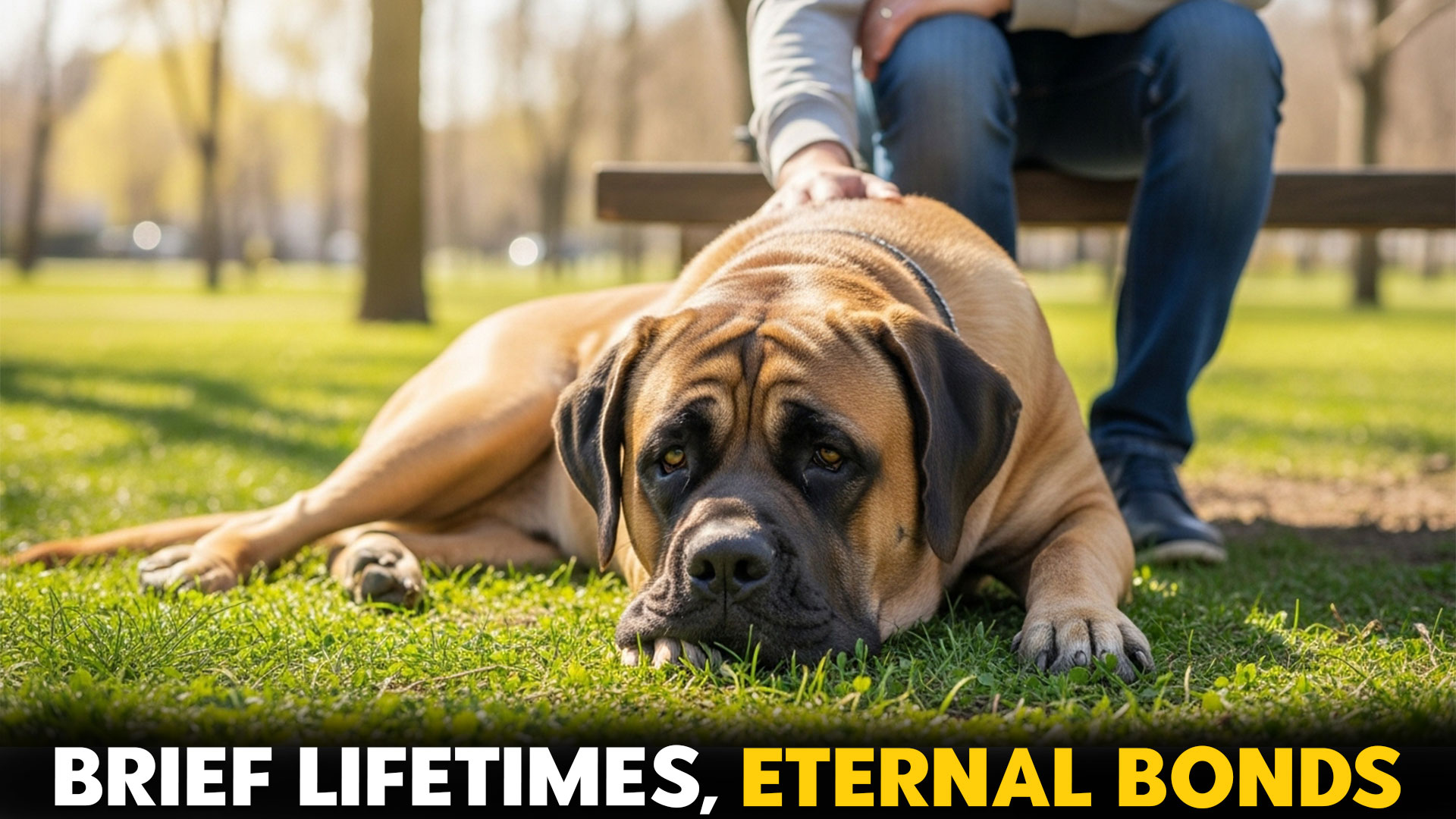Dogs bring endless joy, loyalty, and love into our lives—but unfortunately, their time with us is often too brief. While many short-lived dog breeds are cherished for their vibrant personalities and companionship, some are known for having surprisingly short lifespans.
Certain breeds are more prone to health issues that can shorten their lives. While their time on Earth may be brief, their impact on their families is immeasurable, leaving memories that last far beyond their years.
We’ll take a look at some of the most popular dog breeds with shorter lifespans, exploring why they face this challenge and what makes them so special despite their fleeting time with us. These beloved dogs, despite their energy and charm, seem to leave us all too soon, leaving a void in our hearts.
These are the popular dog breeds with sadly short lifespans, and why some of our most loved companions don’t have as much time with us.
Popular Dog Breeds And Their Sadly Brief Lifetimes
1. Great Dane
The Giant of the Dog World
The Great Dane, the tallest dog breed among the most, originates from Germany, despite its name hinting at Denmark. Initially bred for hunting wild boar and guarding estates, it earned the title “Apollo of dogs” for its impressive size and noble stature, as per Hill’s Pet.
Today, it remains a popular breed admired for its elegance and gentle nature.
A Gentle Giant with a Big Heart
Though massive in size, Great Danes are known for their affectionate, friendly temperament. They’re calm, easygoing, and good with families, though their size can be a challenge for small children or seniors.

Playful yet laid-back, they thrive in spaces where they can stretch out and bond with loved ones.
Tragically Short Lifespan: Why Their Time with Us Is Fleeting
Average dog’s lifespan: 7-10 years
Their large size makes them prone to heart problems, bloat, and joint issues, shortening their time with us.
Rapid growth can lead to developmental issues, affecting their overall health.
Despite their size, they often suffer from conditions like arthritis as they age.
Their brief lives are marked by loyalty, making every moment with them unforgettable.
2. Irish Wolfhound
The Majestic Hound
The Irish Wolfhound, the tallest of all breeds, has a noble history rooted in ancient times. Once revered as fierce hunters capable of taking down wolves, today they are known for their calm demeanor and gentle nature, as noted by the AKC.
Though their size can be intimidating, they are graceful and affectionate, making them beloved companions for those with the space to accommodate them.
The Gentle Giant with a Noble Heart
These dogs are known for their serene and amiable nature, making them excellent companions. Despite their massive size, Irish Wolfhounds are patient with children and get along well with other dogs.
However, their exuberant youth and boisterous energy might not be the best fit for families with very young children, but they’re sweet, loyal, and incredibly affectionate when properly trained.
Tragically Short Lifespan: Why Their Time with Us Is Fleeting
Average lifespan: 6-8 years
Their large size leads to common health problems like heart disease and joint issues, contributing to a shorter lifespan.
They are prone to conditions such as cancer and bloat, which can shorten their time with us.
Rapid growth in their early years can lead to orthopedic issues, affecting their mobility later in life.
Despite their short lives, their gentle nature and loyalty leave an unforgettable impression.
3. Mastiff

The Noble Guardian
The Mastiff is a breed with deep historical roots, dating back to ancient Britain. Known for their majestic size and gentle nature, these guard dogs were originally used by the Romans for guarding sheep and protecting people, according to Britannica.
Today, they are cherished as loving, calm companions, particularly for families with older children, though their imposing size may not suit homes with toddlers.
The Affectionate Protector
Mastiffs are the epitome of calm, good-natured giants. With a strong protective instinct, they may be wary of strangers but are deeply devoted and affectionate toward their family.
Though they enjoy lounging and are known for their loud snoring and drooling, they benefit from regular walks to stay happy and healthy.
Tragically Short Lifespan: Why Their Time with Us Is Fleeting
Average lifespan: 8-10 years
Their immense size leads to heart problems and joint issues, contributing to a shorter lifespan.
Prone to conditions like bloat, which can be life-threatening without immediate intervention.
Rapid growth in puppies often leads to orthopedic issues, shortening their quality of life.
Despite their brief time, they leave a lasting legacy of loyalty, protection, and love.
4. Saint Bernard
The Legendary Rescuer
The Saint Bernard’s heroic past as a life-saving rescue dog in the treacherous Swiss Alps has cemented its place in history.
Named after the 11th-century Saint Bernard of Aosta, who founded hospices for stranded travelers, this giant breed was originally bred to navigate snowstorms and avalanches, as per PDSA.
Gentle Giant with a Big Heart
Saint Bernards are known for their calm, affectionate nature and make wonderful family pets. Despite their immense size, they are patient with children and generally friendly with other pets. Social and loving, they thrive in spacious homes where they can relax and enjoy the company of their loved ones.
Tragically Short Lifespan: Why Their Time with Us Is Fleeting
Average lifespan: 8-10 years
Their large size contributes to health issues like heart disease and hip dysplasia, leading to a shorter life expectancy.
Prone to bloat, which can be life-threatening without immediate intervention.
Rapid growth in puppies often leads to joint problems and arthritis as they age.
Despite their short time with us, their gentle nature and devotion make every moment special.
5. Bulldog

The Enduring Symbol of Courage
The Bulldog, with its unmistakable appearance and courageous heart, has become an enduring symbol of tenacity. Originating in England, this breed was once used for bull baiting, a practice that required immense bravery.
Over time, they’ve transformed into loyal companions, adored for their sweet, gentle nature and their ability to adapt to both city and country living.
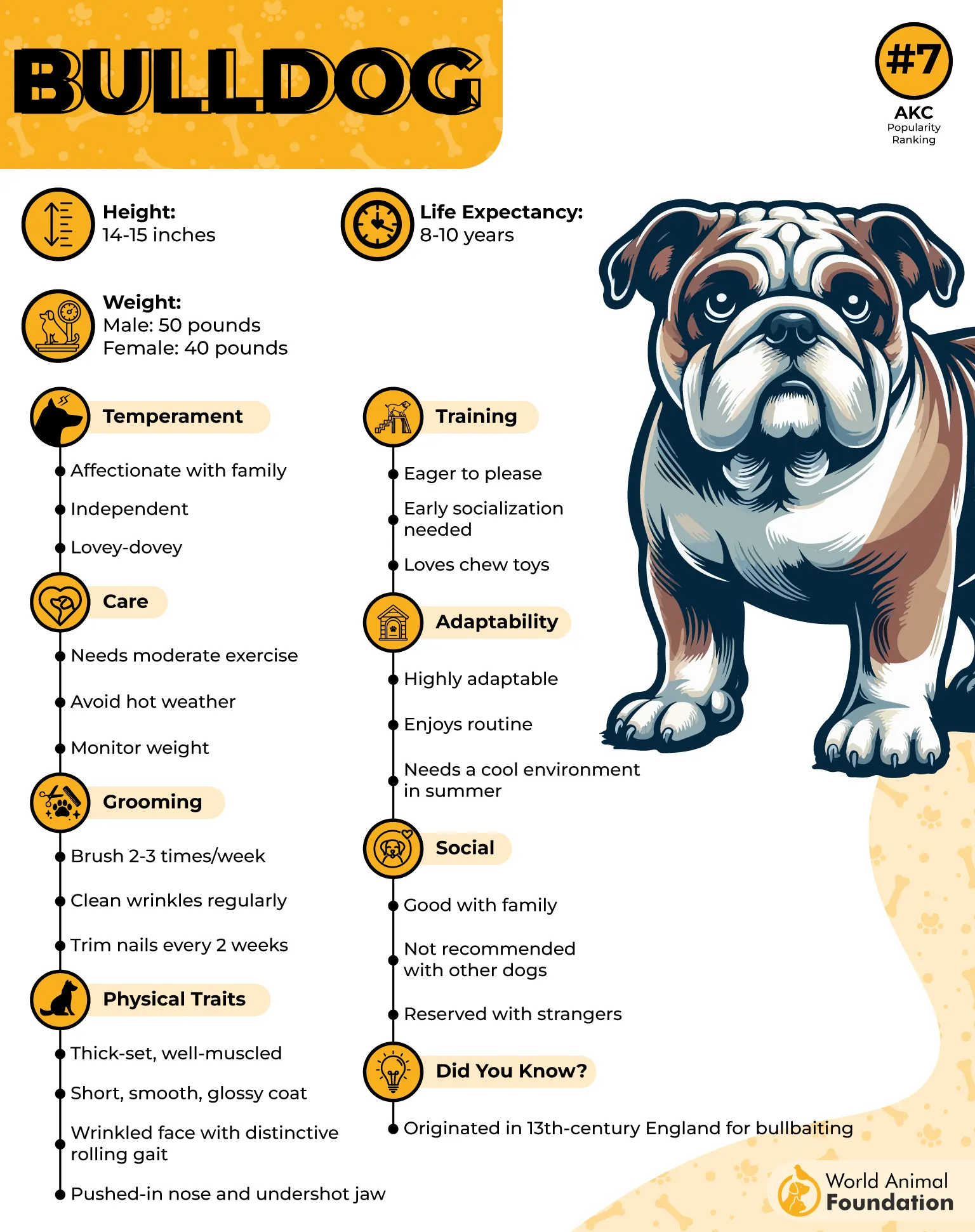
Tough Exterior, Sweet Heart
Despite their tough, muscular build and “sourmug” face, Bulldogs are known for their loving and easygoing personalities. They’re loyal, affectionate dogs, and great with families, particularly children.
While they enjoy moderate physical exercise and brisk walks, they’re also happy lounging on the couch. Though they’re excellent watchdogs, their friendly nature means they’re more likely to cuddle than bark.
Tragically Short Lifespan: Why Their Time with Us Is Fleeting
Average lifespan: 8-10 years
Prone to breathing issues due to their short snouts, Bulldogs can face health problems, especially in hot weather.
Obesity is a common concern, as its low energy needs require a balanced diet and gentle exercise to maintain health.
They are vulnerable to joint issues and heart disease, which can shorten their lives.
Their adorable, wrinkled faces require regular care to avoid skin infections, adding to their health challenges.
6. Newfoundland

The Gentle Giant: Popularity and Origins
Newfoundlands, or “Newfies,” are not just giants in size but in heart as well. Originating from Newfoundland, Canada, these dogs were originally bred to assist fishermen and rescue people from the sea, as per Purina.
Their webbed paws and thick, dense coats make them exceptional swimmers, and despite their size, they have a calm, patient demeanor that makes them wonderful family companions.
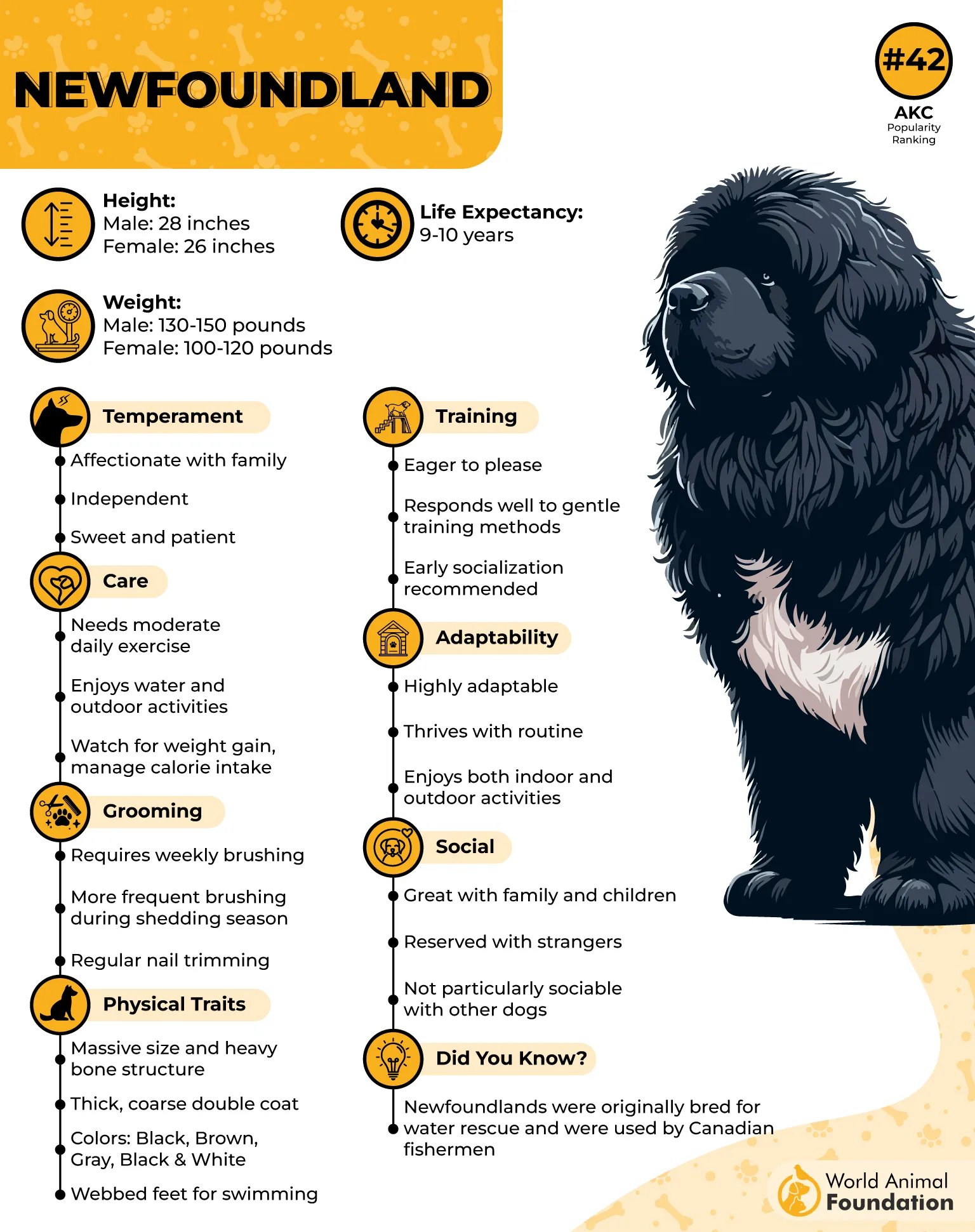
A Heart as Big as Their Frame
Newfies are known for their sweet, gentle nature, making them ideal family pets. Their affectionate disposition extends to children, other dogs, and even small pets.
Their laid-back personality can also make them prone to separation anxiety, so providing companionship and engaging activities is key to their well-being.
Tragically Short Lifespan: Why Their Time with Us Is Fleeting
Average lifespan: 9-10 years
Prone to heart conditions, like dilated cardiomyopathy, which can shorten their lifespan.
Their large size makes them susceptible to joint problems, including hip dysplasia and arthritis.
Newfoundlands are also at risk for bloat, which can be life-threatening without immediate treatment.
Despite their short time with us, their calm and loving nature creates lifelong bonds that endure well beyond their years.
7. Rottweiler
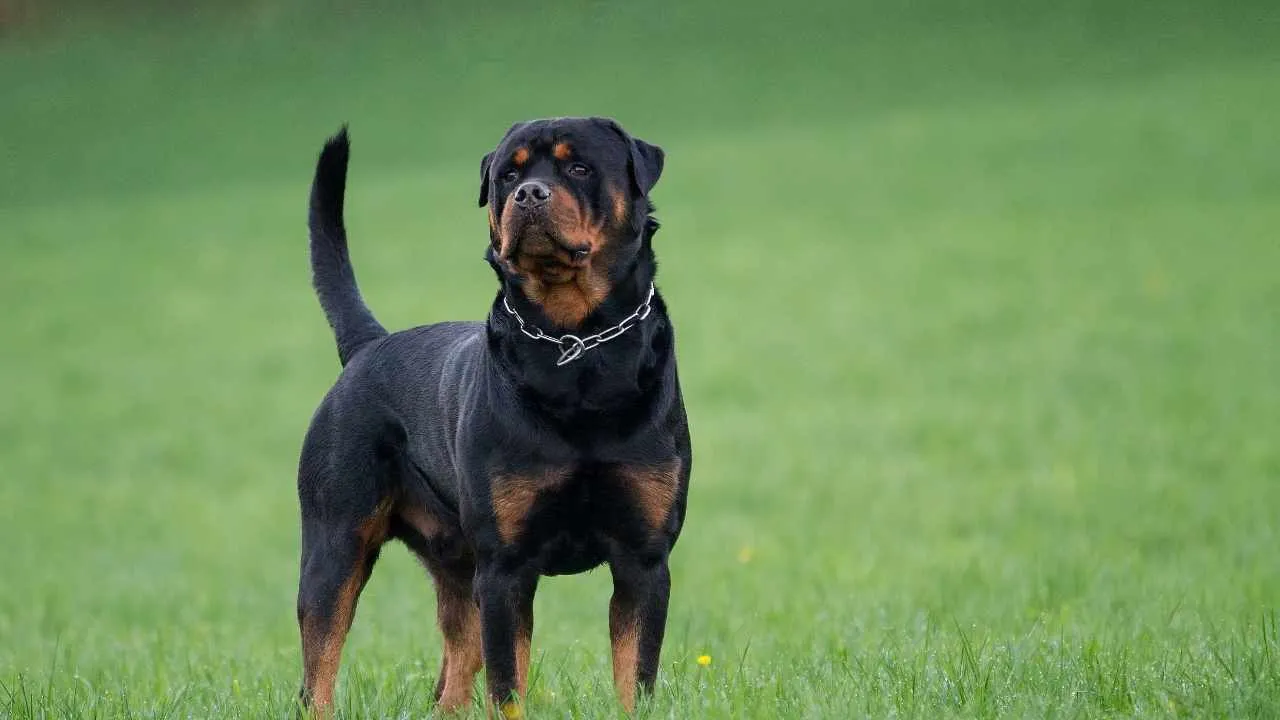
The Loyal Protector: Popularity and Origins
Rottweilers are deeply rooted in history, dating back to Roman times when they were used to herd cattle and protect valuables. Originating from Rottweil, Germany, this breed has earned a reputation for its powerful build and unyielding loyalty.
Once a working dog, the Rottweiler is now popular as a family companion and protection dog, thriving with owners who understand its strong-willed nature.
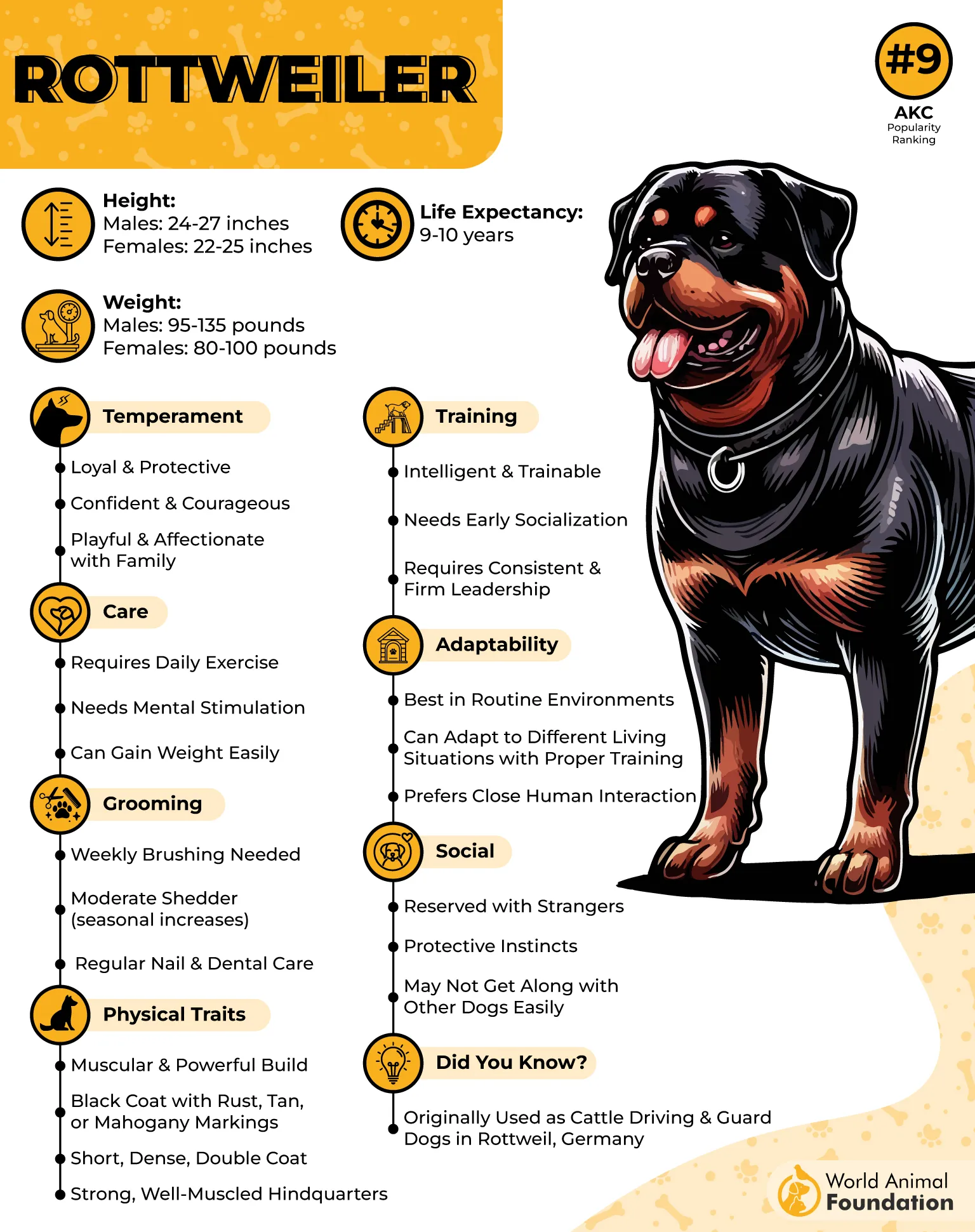
Intelligent, Protective, and Family-Oriented
Rottweilers are known for their intelligence, loyalty, and protective instincts. With proper training and socialization from a young age, they become affectionate and devoted companions, especially to older children and family members.
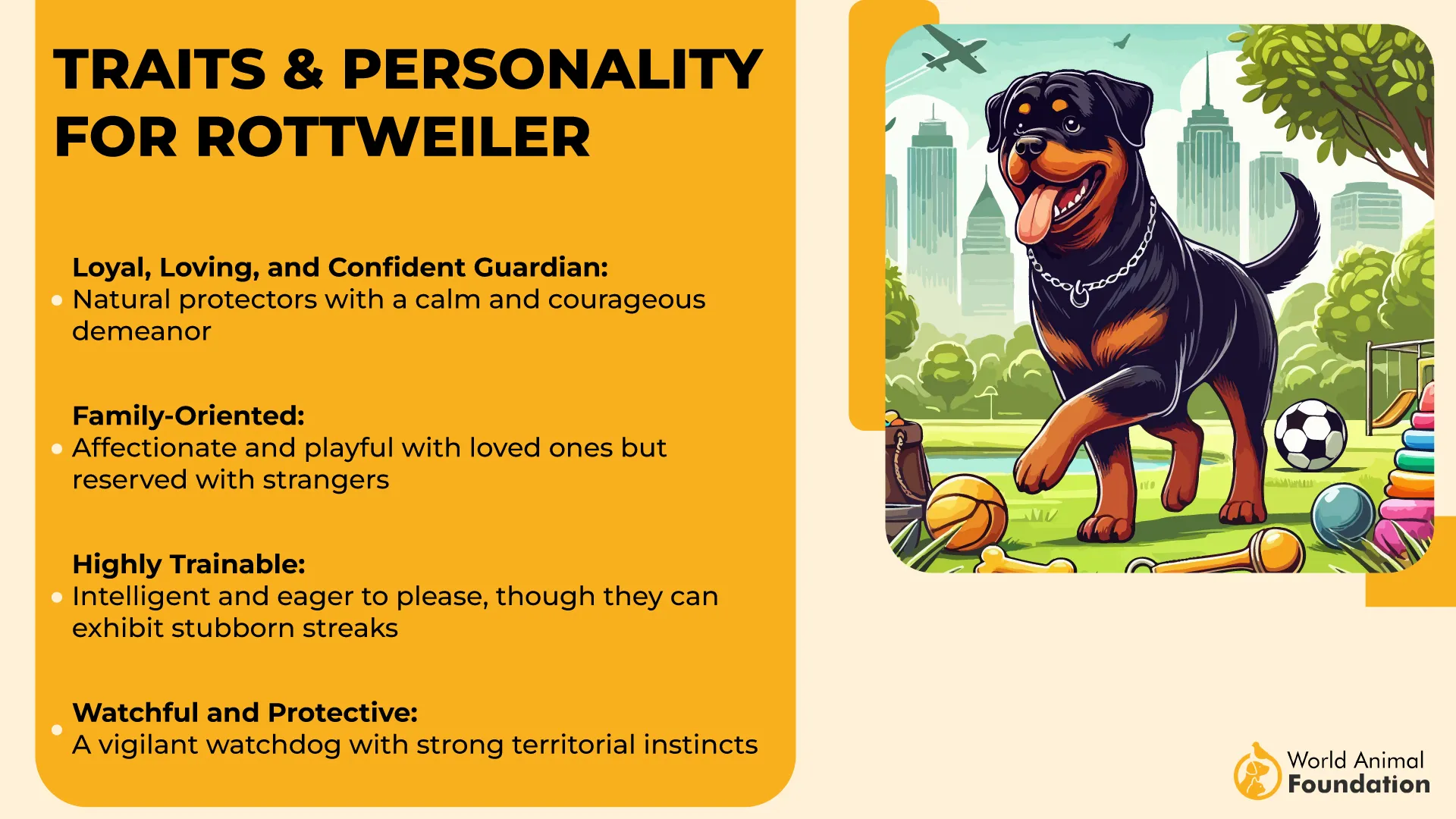
Their natural herding instincts can make them cautious with other pets, particularly smaller animals, but they bond deeply with their family, as per WebMD.
Tragically Short Lifespan: Why Their Time with Us Is Fleeting
Average lifespan: 8-10 years
Rottweilers are prone to joint problems such as hip and elbow dysplasia, which can limit their mobility.
Their large size and protective nature make them more susceptible to heart conditions, including dilated cardiomyopathy.
Overweight Rottweilers can suffer from obesity-related issues like diabetes, which can further shorten their lifespan.
Their tendency for separation anxiety when left alone can lead to destructive behaviors and stress-related health problems.
Conclusion
Many popular dog breeds are sadly known for their relatively short life expectancy, often living only a few years less than other dogs.
While large breeds, in particular, tend to have a shorter lifespan due to genetics and health challenges such as joint issues and heart disease, smaller dog breeds typically enjoy longer lives.
For pet parents, the key to ensuring their furry companions enjoy a long and healthy life lies in proactive care. Regular vet visits, early detection of health issues, and positive reinforcement during training can make a world of difference.
Larger dogs, such as the Great Danes, require more attention to joint health and heart conditions.
Although no dog can live forever, with the right care, many can live well into their senior years. Elderly dogs, regardless of breed, thrive in environments where they receive the love and attention they need to stay active and healthy.
Whether it’s a quick grooming session or a walk with your furry friend, each moment spent together helps ensure that they live the longest, healthiest life possible.


